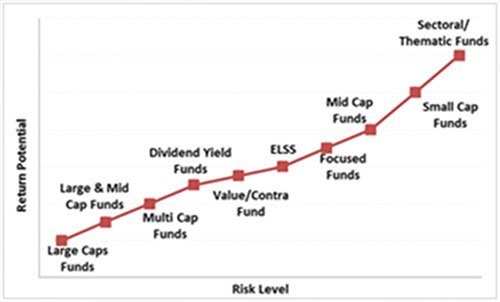Did Focused Funds Reward Investors Handsomely in the Equity Market Rally?
Listen to Did Focused Funds Reward Investors Handsomely in the Equity Market Rally?
00:00
00:00
"Diversification is protection against ignorance. It makes little sense if you know what you are doing."-Warren Buffet
Many equity market investors take the aforesaid statement of the legendary investor too seriously -- and mostly without understanding the true meaning of it.
Focused Funds, which hold the mandate to hold a concentrated portfolio (maximum of 30 stocks), have witnessed an increase in folio count to 42 lakh as of July 2021 compared to 37 lakh a year ago, reveals the AMFI data. Investments have flowed into Focused Funds, and the Assets Under Management (AUM) of Focused Funds (at Rs 80,871 crore of July 31, 2021) today comprises approximately 7% of the total AUM of open-ended equity mutual funds. This goes to show, more investors are now investing in Focused Funds.
If you have been investing in Focused Funds expecting that their conviction-oriented approach would reward you handsomely, then that is not always the case. On the contrary, due to a concentrated portfolio, the risk you are exposed to will be on a higher side. A Focused Fund would do well only when the underlying conviction-driven bets taken by its fund manager pay off and outperform the broader market.
Graph: Placement of Focused Funds on the risk-return spectrum
 Note: For illustrative purpose only
Note: For illustrative purpose only
(Source: PersonalFN Research)
The fund manager of a Focused Fund may hold the portfolio across market capitalization -- large-cap, mid-cap, small-cap -- with a buy-and-hold strategy, depending on how he/she envisages the growth potential. Under the current market conditions, a predominant number of Focused Funds maintained a multi-cap or large-cap orientation portfolio, and here's how they have fared vis-a-vis the other sub-categories of equity-oriented mutual funds...
Table 1: Underperformance of Focused Funds
| Category |
Returns (Absolute %) |
Returns (CAGR %) |
| 6 Months |
1 Year |
2 Years |
3 Years |
5 Years |
7 Years |
10 Years |
| Small-cap Funds |
32.5 |
90.8 |
43.5 |
18.7 |
17.2 |
18.2 |
18.8 |
| Mid-cap Funds |
21.6 |
66.9 |
34.2 |
16.8 |
15.6 |
16.5 |
17.4 |
| Multi-cap Funds |
19.9 |
61.0 |
28.6 |
16.7 |
15.3 |
14.9 |
15.9 |
| Contra Funds |
14.2 |
59.1 |
29.4 |
15.4 |
15.6 |
14.9 |
15.3 |
| Large & Mid-Cap Funds |
16.6 |
56.4 |
27.2 |
14.6 |
14.6 |
14.9 |
15.6 |
| Flexi-cap Funds |
13.3 |
50.2 |
24.4 |
14.0 |
14.1 |
13.7 |
14.3 |
| Dividend Yield Funds |
21.4 |
54.5 |
28.0 |
13.9 |
14.4 |
12.7 |
13.3 |
| Focused Funds |
12.1 |
48.7 |
24.4 |
13.4 |
14.1 |
13.7 |
14.4 |
| Large-cap Funds |
9.6 |
44.9 |
21.6 |
12.7 |
12.9 |
12.4 |
13.4 |
| Value Funds |
15.4 |
57.6 |
25.4 |
11.9 |
13.0 |
13.7 |
15.3 |
| NIFTY 500 - TRI |
12.5 |
52.1 |
25.4 |
14.1 |
15.0 |
13.6 |
14.3 |
| NIFTY 50 - TRI |
8.8 |
46.5 |
22.6 |
14.0 |
15.0 |
12.7 |
13.8 |
| Nifty LargeMidcap 250 Index - TRI |
15.4 |
58.4 |
28.9 |
15.1 |
16.2 |
15.6 |
16.0 |
| Nifty Smallcap 250 - TRI |
32.6 |
92.6 |
40.8 |
15.0 |
14.6 |
14.2 |
14.8 |
| Nifty Midcap 150 - TRI |
21.4 |
71.0 |
35.2 |
16.6 |
17.5 |
17.9 |
17.6 |
Data as of August 12, 2021
Growth Option and Direct Plan considered for evaluation.
(Source: ACE MF, PersonalFN Research)
Over the last 12-18 months, although the overall market breadth has been strong, i.e. more stocks have advanced than declined; the small and mid-cap companies have largely driven the performance of broader markets.
The recent underperformance of focused funds has weighed even on the 3-year compounded annual returns. As a result, focused funds have underperformed most other diversified equity-oriented categories.
Having said that, there were times when they did well as a category. If you recall, between January 2018 and March 2020, mid and small-cap stocks had a tough time in Indian equity markets. Even in the large-cap space, only a few heavyweights stocks provided props to the leading indices; during such times focused funds have fared well.
The equation changed ever since the pandemic broke out, Focused Funds have underperformed compared to the other sub-categories of equity mutual funds and some to their respective benchmark index. A few Focused Funds, of course, mainly the smaller schemes with high-conviction calls on sectors and stocks backed by a sound investment strategy, have done well.
Table 2: Report Card of Focused Funds
Data as of August 12, 2021
Growth Option and Direct Plan considered.
(Source: ACE MF, PersonalFN Research)
IIFL Focused Equity Fund for example by holding over 50% in large-cap stocks, over 15% in mid-caps, and another 15% in small-caps has delivered stellar returns over the 3-year and 5-year periods. It has fared well across a host of quantitative and qualitative parameters.
Similarly, the Principal Focused Multicap Fund by holding around 35% in large-caps, 15% in mid-caps, and 29% in small caps, has displayed an appealing performance.
SBI Focused Equity Fund by investing nearly 9% of its assets in foreign equities (as of July 31, 2021)---into tech companies such as Alphabet Inc and Nvidia Corporation---as well domestic equities across capitalisation has adequately compensated its investors.
Should you invest in Focused Funds?
 (Image source: pixabay.com; photo created by Dmitriy)
(Image source: pixabay.com; photo created by Dmitriy)
A point to note is, a Focused Fund will have its share of cyclicality depending on the kind of securities it holds in the portfolio.
Diversification and concentration are two different investing approaches. While the former reduces risk and optimises return, the latter increases the risk along with the chance of potential returns.
Bear in mind, a Focused Fund due to a concentrated portfolio will expose you to higher risk. Hence, only if you have a higher risk tolerance and investment and an investment time horizon of at least 5 years, you may consider amongst the best Focused Funds.
When you are adding a Focused Fund to your mutual fund portfolio, do not commit the following mistakes:
-
Give importance to the short-term market outlook
-
Depend extensively on the past track-record of a scheme
-
Not evaluating the risk involved objectively
-
Rely blindly on star-ratings
-
Disregarding qualitative aspects associated with mutual fund selection
-
Ignore your personalised asset allocation
-
Relying on friends and relatives who may be unqualified to give you prudent advice on mutual funds
You see, not all actively managed mutual fund schemes have been able to generate alpha; some have failed. Hence, selection matters!
The important factor while selecting any scheme is to evaluate the consistency of its performance based on quantitative (viz. returns across time frame, returns across market cycles, risk ratios, the expense ratio, portfolio turnover, etc.) and qualitative parameters (viz. portfolio characteristics, the credential of the fund management team, among other aspects).
Furthermore, set your return expectation right, do not get swayed by any irrational exuberance, it may prove hazardous to your wealth and health. The challenges posed by the COVID-19 pandemic and escalating geopolitical tensions may weigh on the returns you earn.
Currently, you need to follow a smart strategy where risks and returns are well balanced out. Have you heard of Core and Satellite strategy? It is a time-tested investment approach followed by some of the most successful equity investors in the world.
The term 'Core' applies to the more stable, long-term holdings of the portfolio, while the term 'Satellite' applies to the strategic portion that would help push up the overall returns of the portfolio, across market conditions.
The 'Core' holding should comprise around 65-70% of your equity mutual fund portfolio and consist of a Large-cap Fund, Flexi-cap Fund, and Value Fund/Contra Fund. Whereas, the 'Satellite' holdings of the portfolio can be around 30-35% comprising of a Mid-cap Fund and an Aggressive Hybrid Fund.
A Focused Fund does not form a part of the 'Core' neither the 'Satellite' component of the portfolio.
You mainly need diversified equity funds selected with some special care.
What is the special care to be taken to build a mutual fund portfolio on the Core & Satellite approach?
Well, you need to follow a few ground rules:
-
Consider funds that have a strong track record of at least 5 years and have been amongst the top performers in their respective categories.
-
The schemes should be diversified across investment styles and fund management.
-
Ensure that each selected scheme abides with its stated objectives, indicated asset allocation, and investment style.
-
You should not only invest across investment styles (such as growth and value), but also across fund houses.
-
The mutual fund schemes should be managed by experienced and competent fund managers and belong to fund houses that have well-defined investment systems and processes in place.
-
Not more than five schemes managed by the same fund manager should be included in the portfolio.
-
Not more than two schemes from the same fund house shall be included in the portfolio.
-
Each scheme that is to be included in the portfolio should have seen an outperformance over at least three market cycles.
-
You should restrict the count of mutual fund schemes in your portfolio to seven.
By selecting schemes wisely, structuring the portfolio between the Core and Satellite portions, and timely reviewing the holdings therein, you will be able to add stability to the portfolio and at the same time strategically boost your portfolio returns.
Here are six key benefits of following the core & Satellite approach:
-
Facilitates optimal diversification among equity mutual fund schemes
-
Reduces the need to frequently churn your entire portfolio
-
Reduces the risk to your portfolio
-
Enables you to benefit from a variety of investment styles and strategies
-
Creates wealth cushioning the downside
-
Helps you potentially outperform the market
Given that volatility in the Indian equity market would intensify in the near future, I suggest taking the Systematic Investment Plan (SIP) route while you build the portfolio of equity-oriented mutual fund schemes following the 'Core and Satellite' approach. If you wish to invest in a readymade portfolio of top recommended equity mutual funds based on the 'Core & Satellite' approach to investing, I suggest subscribing to PersonalFN's Premium Report, "The Strategic Funds Portfolio For 2025 (2020 Edition)".

Note, the Core & Satellite investment strategy may work for you in 2021 and beyond. This premium report will help you build an optimum equity mutual funds portfolio for 2025 without any effort on your part. At PersonalFN, we follow a comprehensive S.M.A.R.T Score Matrix to select the best mutual funds. We evaluate...
S - Systems and Processes
M - Market Cycle Performance
A - Asset Management Style
R - Risk-Reward Ratios
T - Performance Track Record
It has helped our valued mutual fund research subscribers to own some of the best equity mutual fund schemes in the investment portfolio with a commendable long-term performance track record.
If you haven't subscribed to PersonalFN's Premium Report, "The Strategic Funds Portfolio For 2025 (2021 Edition)" yet, do it now!
Happy Investing!
Warm Regards,
Rounaq Neroy
Editor Daily Wealth Letter
Join Now: PersonalFN is now on Telegram. Join FREE Today to get ‘Daily Wealth Letter’ and Exclusive Updates on Mutual Funds